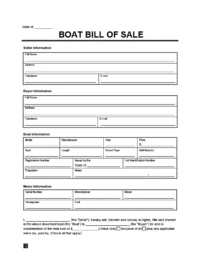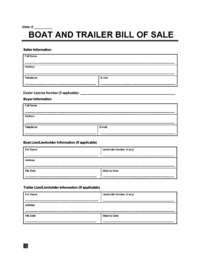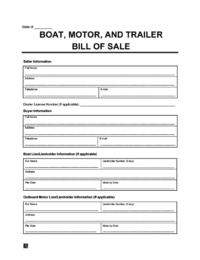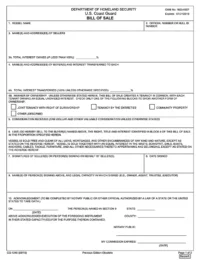A boat bill of sale is a legal document recording the sale of a boat between two parties: a seller and a buyer. Within this document, the seller agrees to transfer boat ownership to the buyer for a certain fee.
You need this form when buying or selling a boat because it outlines the terms of the sale, prevents disputes, and serves as proof of ownership for the buyer so they can register their new boat.
Supplemental Form
If the boat has an accompanying trailer, you can record the sale of multiple items (for example, a boat, motor, and trailer) on a single form or an accompanying trailer bill of sale form.
Boat Bill of Sale – By State
- Alabama
- Alaska
- Arizona
- Arkansas
- California
- Colorado
- Connecticut
- Delaware
- District of Columbia
- Florida
- Georgia
- Hawaii
- Idaho
- Illinois
- Indiana
- Iowa
- Kansas
- Kentucky
- Louisiana
- Maine
- Maryland
- Massachusetts
- Michigan
- Minnesota
- Mississippi
- Missouri
- Montana
- Nebraska
- Nevada
- New Hampshire
- New Jersey
- New Mexico
- New York
- North Carolina
- North Dakota
- Ohio
- Oklahoma
- Oregon
- Pennsylvania
- Rhode Island
- South Carolina
- South Dakota
- Tennessee
- Texas
- Utah
- Vermont
- Virginia
- Washington
- West Virginia
- Wisconsin
- Wyoming
Boat Bill of Sale – By Type
Explore our different forms to get the right template for your boat setup:
Use this template if you’re selling a motorless boat or a boat with an internal motor.
Examples include canoes, sailboats, houseboats, and jet skis.
For a Boat
Use this template to sell a boat with an outboard motor and its trailer.
Outboard motors aren’t permanent parts of the boat, so they must be listed separately on the bill of sale form, even if a trailer isn’t included in the transaction.
For a Boat, Motor, and Trailer
If your boat is federally documented (registered with the U.S. Coast Guard), you need an official Coast Guard bill of sale to complete the transfer.
For a Coast Guard Vessel
How to Sell a Boat

Step 1 – Decide What You’re Selling
Firstly, you’ll need to decide what you’re selling. Will you sell just a boat or include a motor and/or trailer?
Whatever it is you’re selling, make sure you include everything in the final value of the sales price.
Common Types of Boats
You may sell or buy one of the following types of boats or water vessels using a boat bill of sale:
- Yacht
- Catamaran
- Tugboat
- Skiff
- Sailboat
- Canoe
- Rowboat
- Kayak
- Power/motorboat
- Jet ski
Step 2 – Prepare the Boat for Sale
You need to take a few steps to prepare your boat for sale. You’ll need to:
- Get paperwork in order: Ensure you have the title and registration for each component. Most states require this information for sale. Plus, it assures the buyer that you’re the owner and the vessel has no liens.
- Collect maintenance records: A potential buyer may ask for records of any maintenance work you’ve had for the boat to verify its condition.
- Clean your vessel: Clean your vessel’s interior and exterior to attract more potential buyers. Address cosmetic issues, fix mechanical problems, and remove everything not part of the sale.
- Photograph your boat: Take several photos of your boat from different angles in good lighting.
Step 3 – Determine Your Boat’s Value
To determine your boat’s value, you’ll need to:
- Decide whether to sell privately or commercially. You may wish to hire a broker to help sell your boat, especially if it’s a higher-cost watercraft. On the other hand, selling your boat on your own lets you manage the process while eliminating fees and commission costs, but it can be more time-consuming.
- Determine market value. To get an idea of the market value of your boat, you can use a price-checker tool like JD Power or BoatTrader. Or, you can search for local listings of a similar make and model. Factors such as condition, age, and demand can significantly impact market value.
A vessel’s average sales price may not accurately represent how much your boat is worth. If you’ve made extensive modifications, they could affect the value. Ensure you consider everything when calculating the sales price.
Decide on an asking price and the lowest offer you’ll consider before you list.
Step 4 – List Your Boat for Sale
Several websites help private boat sellers reach buyers. To reach a wider audience, create multiple listings across sites like Boat Trader, The Hull Truth, BoatCrazy, boats.com, Craigslist, and eBay. For high-end and specialty boats like yachts and sailboats, try YachtWorld.
In addition to several clear photos of your boat, provide a detailed description of its condition and features and any accompanying motor, trailer, or accessories.
Make sure you include the following information in your post:
- Make, model, and year
- Dimensions
- Condition
- Repairs or improvements
- Terms of the sale (cash-only, delivery available, etc.)
If you want to offer a warranty on the boat, mention it here. Otherwise, include terms like “as-is” or “sale final” in the listing description.
Step 5 – Present Your Boat to Potential Buyers
Now that you’ve listed your boat for sale online, you can show it to potential buyers. For ease of access, you’ll want your boat stationed at a dock so buyers can understand what it is like on the water. You could also consider parking your boat on land, in a trailer, or on a stand.
Before meeting potential buyers, ensure the following:
- You’re honest and up-front about the boat.
- You know the boat inside and out.
- The boat is in selling condition.
- You’re prepared to communicate and negotiate with buyers.
- You know your lowest asking price.
Step 6 – Write a Bill of Sale and Gather Relevant Documents
Once you’ve found a buyer, you can fill out a bill of sale template to finalize the transaction. Distribute a copy to the buyer so they can review it.
Also, gather the following documents:
- Title: Proof you own the boat.
- Registration: Current registration in your state.
- Proof of Paid Loan: Evidence that you’ve paid off the loan attached to the boat.
- Trailer Documentation: Proof the trailer is in good condition and can haul a boat without it being dangerous.
- Receipts for Maintenance/Repairs: Proof of you taking care of the boat while you owned it.
- Warranties: Any guarantees you want to transfer in the sale.
Step 7 – Collect Payment
Once you agree on a price with the buyer, you can finalize the boat sale. The buyer must pay you before signing the document.
Don’t hand over the keys or ownership documents until the buyer’s funds have cleared.
It would be best to negotiate which party will be subject to the sales tax; typically, both parties split it. To close the sale:
- The buyer needs to make payment in full.
- The seller must sign the title to the buyer and hand over any current registration documents.
Step 8 – Sign and Notarize
After completing the bill of sale form and receiving payment in full, you and the buyer can sign the document according to your state’s requirements.
Some states require the buyer and seller to sign in the presence of a notary public for the form to be valid. If your state doesn’t require boat bills of sale to be notarized, it’s still a good idea to have a notary witness the deal in case a dispute arises.
After the sale is complete, make a copy of the signed form for your records. The buyer should keep the original copy for registration purposes.
What to Include in a Boat Bill of Sale
A valid bill of sale for a boat, jet ski, or other watercraft vessels should include the following components:
- Parties’ information: The buyer’s and seller’s names and contact information.
- Watercraft description: Details about the watercraft, including its current condition, hull identification number, make, model, and year.
- Registration information and title number: Any registration information and title numbers for the boat.
- Payment method: Clarification on how the buyer will pay (via cash, personal or certified check, credit card, etc.)
- Purchase price: The agreed-upon purchase price.
- Sale location and date: When and where the sale occurred.
- Signatures: Signatures of both parties.
- Notarization: Some states require notarization to validate the document. Even if your jurisdiction doesn’t require notarization, you may consider having a notary witness both parties’ signatures to increase its legitimacy.
You can also specify if the boat comes with a warranty. If it doesn’t, you may include an “as-is” clause, meaning the buyer agrees to purchase the vessel in its current condition.
How to Write a Boat Bill of Sale
Step 1 – Fill in the Buyer and Seller Information
Once the buyer and seller agree on all the transaction details, arrange to meet in person to complete the sale. It’s a good idea to have both parties show ID to verify their personal information is correct and prevent fraud.
You must include both parties’ names, addresses, and contact details.
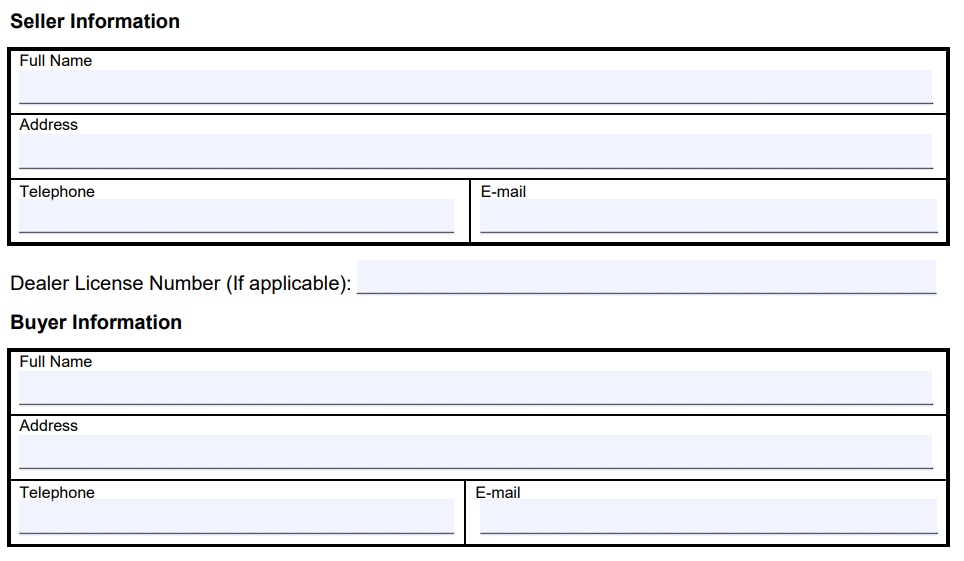
Step 2 – Fill in the Boat, Motor, and Trailer Details
Fill out the boat details, including year, make, model, HIN (hull identification number), dimensions, etc. You can usually find your boat’s hull ID number on the right side of the transom (rear of the boat).
Include outboard motor information like serial number, model, and horsepower, which you can often find on the plate attached to the motor.
Trailer details, such as the vehicle identification number (VIN) and weight, are usually on a sticker or plaque attached to the frame.
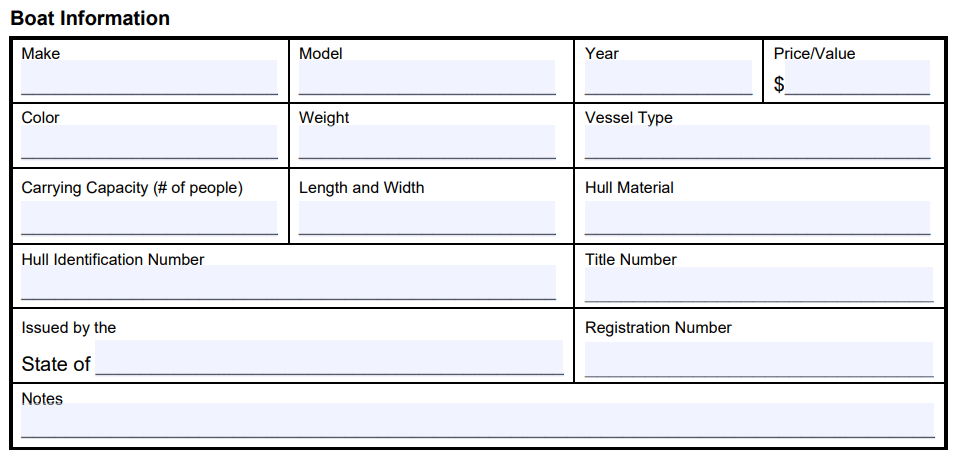
Step 3 – Fill in the Selling Price and Payment Method
The buyer and seller should agree on a purchase price and payment method.
The buyer must pay sales tax when registering their new boat, but you might split or cover the sales tax cost by deducting the applicable taxes from the selling price.
Payment methods can include the following:
- Personal check
- Cashier’s check
- Money order
- Cash
- Credit card
- PayPal
If the boat is a gift, fill out your relationship to the recipient and the boat’s total value and other items included in the transfer.

Step 4 – Sign and Notarize
Once the buyer pays, you can sign the form to finalize the transaction. Some states require boat bills of sale to be notarized.
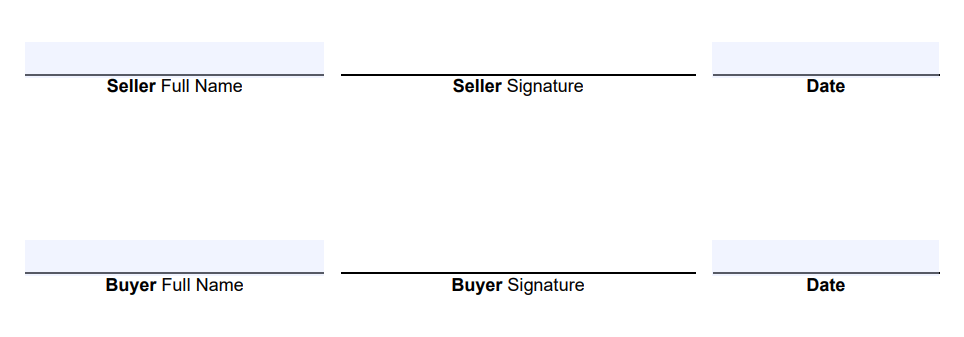
Boat Bill of Sale Sample
Download a boat bill of sale template below in PDF or Word format.

Frequently Asked Questions
Can you register a boat with a bill of sale?
You can use this document as proof of purchase to apply for the legal title with the state agency that handles boat registration.
Check your state’s requirements to determine if you need to register the boat. If you’re purchasing a trailer, you may need to register that too.
Can I buy a boat with just a bill of sale?
Yes, you can buy a boat with just this document. However, the boat must not have a title. The bill of sale must provide all the necessary details so there’s sufficient proof the transaction took place.
If a title is attached to the boat, the seller must transfer the title to you for you to legally be the new owner.
Can you sell a boat without a bill of sale?
Yes, you can sell a boat without this document. However, this approach may not be wise because you wouldn’t have definitive proof of a transaction and the resulting change in ownership. Both parties to the sale may experience legal ramifications later.
For example, say you sold your boat to a buyer without a bill of sale, and the buyer got into an accident where they damaged another vessel. The owner of the damaged vessel could take you, the original owner, to court for compensation.
As the boat is still in your name and there is no proof of a transaction, it won’t be easy to prove your innocence.
Does a boat bill of sale need to be notarized?
A boat bill of sale may need to be notarized to be legally binding, depending on the state where the sale occurs. Many states require this document notarized or witnessed by at least two people.
